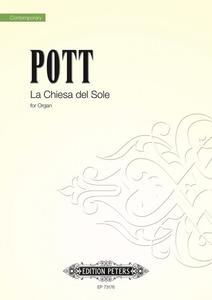Pott, Francis 
![Cover image of the score as published on 19 January 2018 by Edition Peters Ltd. [thumbnail of Cover image of the score as published on 19 January 2018 by Edition Peters Ltd.]](https://repository.uwl.ac.uk/4336/1.hassmallThumbnailVersion/EP-La%20Chiesa%20del%20Sole.jpg)  Preview |
Image (JPEG) (Cover image of the score as published on 19 January 2018 by Edition Peters Ltd.)
EP-La Chiesa del Sole.jpg - Published Version Download (29kB) | Preview |
Abstract
23-minute recital work for organ solo, commissioned by the Dean & Chapter of Manchester Cathedral for inaugural recital on the Cathedral's new organ [14 September 2017].
Composer's programme note, as published in the ACIS CD release of the work:
This music fulfils a 40-year-old wish to respond to the 11th-century Basilica of San Miniato, overlooking the Tuscan metropolis of Florence from its hilltop in ‘Oltrarno’, the district so named because it lies across the River Arno from the main part of the city (where I lived for some charmed months during 1976). The marbled façade of the church is a magnet for the sun, which lends it a supernaturally luminescent quality. The interior is no less remarkable. The music articulates a personal reaction to making one’s ascent towards the piazza in front of the Basilica on a summer’s evening, and seeks to evoke the uniquely numinous, uplifting atmosphere of the building’s internal spaces.
Structurally, this piece can be simplistically summarised as a free fantasia and an ensuing movement which starts as a fugue but gradually transmutes into a triumphant toccata. The music’s declamatory opening statement permeates the entire piece, making both quiet and climatic reappearances and culminating in a fanfare-like peroration immediately before the very final chord. A spacious introduction leads into a more measured section whose opening articulates two fundamental elements: a brief motif consisting of a descending three-note scale plus a leap back up to its first note, and the interval of a perfect fourth – this latter being of seminal importance to the work as a whole. Rhapsodic exploration of this and the opening bars of the piece leads eventually to a brief cadenza-like passage and the launching of a scherzo of dance-like character. In this the interval of a fourth (both ascending and descending) is again prominent, as are interlocking, rising three-note groups and a descending scale.
The request for this work had come soon after the musical world was stunned and saddened to learn of the death in New York of the inspirational British organist and choir director, John Scott. I had known John Scott since we were both students at Cambridge University in the 1970s. He was the first organist of international reputation to champion my music for the instrument, and two of my early pieces bear a dedication to him. It was therefore natural and fitting that I should ask the Dean and Chapter at Manchester for their blessing on a secondary dedication to John’s memory, not least because his home city of Wakefield lies only just over thirty miles away. This was warmly received and my score is inscribed accordingly. Thus, before long the scherzo music becomes more subdued and gives way to an introspective passage (in which the same melodic building blocks are apparent). The earlier music returns, but remains suffused with the preceding mood and recedes gradually, expiring after another cadenza-like passage.
A chorale-like statement is now heard. This launches a fugue whose subject arises naturally from disparate elements heard hitherto, including the chorale. The fugue proves to be less a strict example of the genre, more an incidentally-fugal study in gradual escalation, proceeding through a series of marginal accelerations and eventually moving into triple, rather than quadruple, time. Soon, triplet figuration recalls passages from the introduction of the work and from the earlier scherzo, which is now revisited and expanded in more extrovert fashion. Again this is interrupted, with the introspective music making a modified return, through which the triplet patterns this time persist. Thereafter, another gradual acceleration recalls the earlier stages of the fugue amid intermittent outbreaks of irregular dance rhythms. The toccata-like music intensifies until eventually the chorale theme breaks forth triumphantly. Its broad restatement leads to a dramatic coda in which great virtuosity is demanded of the performer, particularly in the pedal department. Having begun ‘at an angle’ to E major, the music now homes in definitively on that key – but is momentarily interrupted by a tangential declamation of the work’s opening bar from the organ’s reeds, before the music achieves final affirmation with an unambiguous major chord.
| Item Type: | Composition |
|---|---|
| Additional Information: | The score was published by Edition Peters on Friday 19th January 2018: ISMN 979-0-57701-512-5. Score number: EP 73176. It has been recorded for CD (on the ACIS label: APL 67065) by Christian Wilson on the Marcussen organ in the Chapel of Tonbridge School, Kent. |
| Subjects: | Music > Composition |
| Related URLs: | |
| Date Deposited: | 08 Mar 2018 |
| URI: | https://repository.uwl.ac.uk/id/eprint/4336 |
Downloads
Downloads per month over past year
Actions (admin access)
 |
 Lists
Lists Lists
Lists